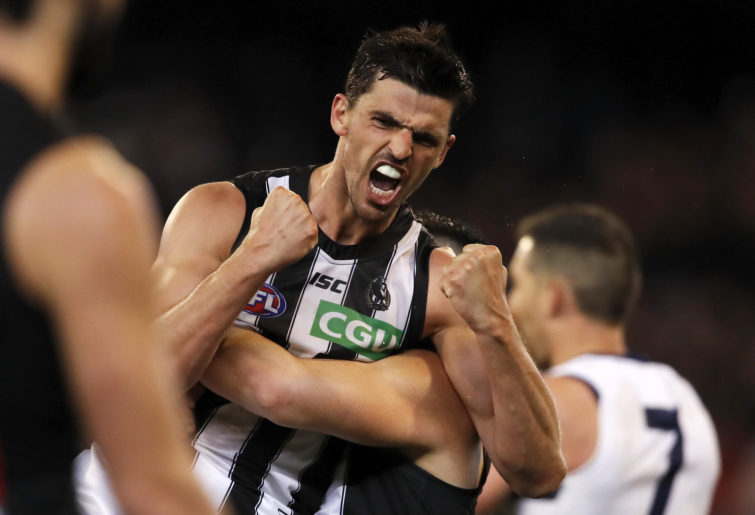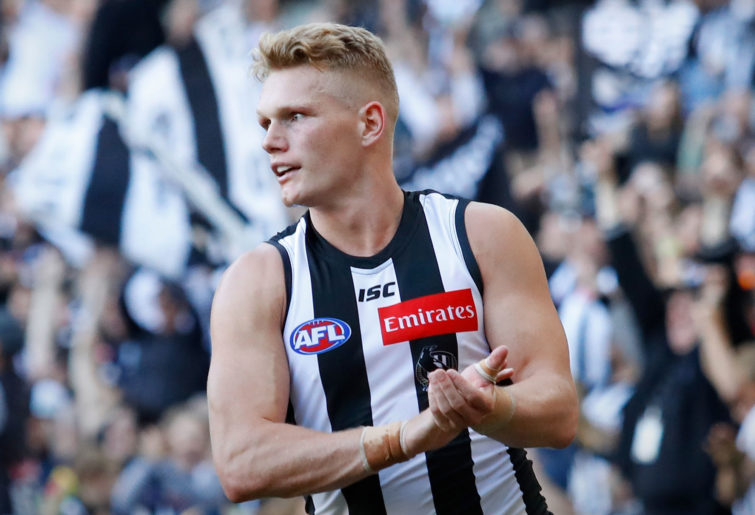AFL News: North OF Melbourne? McGuire's bold idea to rejuvenate Roos, Scott slams sub rule after Anzac Day drama
Eddie McGuire's latest bold idea has dropped - for North Melbourne to take over the outskirts of Melbourne and use it to rejuvenate the…
Opinion
I’ve always believed you can compartmentalise footballers into five categories.
1. Playmakers: these players create the play, and bring teammates into the game.
2. Linkers: they’re fed the ball and provide run and carry.
3. Finishers: finish off play.
4. Role players: these players are given a specific job to do. They might be a tagger, defensive forward, or defender, who exist primarily to stop an opponent, rather than create play.
5. Plodders: these players aren’t good enough for the highest level.
At the very least, every player exists primarily in one category, but will be capable of other traits. For example, Fremantle’s Nat Fyfe is a playmaker. But he can also be a linker and a finisher. But foremost he is an architect who makes the game happen around him, and brings his teammates into it.
I consider Collingwood’s Steele Sidebottom more a linker and finisher. When Collingwood has struggled, so has Sidebottom.
Compare that to somebody like Carlton’s Patrick Cripps, who was still dominant when Carlton were struggling. But when Collingwood is afire, Sidebottom is everywhere providing run and carry, as well as linkages. Up forward, he’s a polished finisher who capitalises on half-chances.
He’ll still exhibit playmaker traits, but that won’t be where his game thrives.
Role players will rarely be playmakers, although they are expected to provide linkages. Collingwood’s Chris Mayne is a good example. Each week he is given a job.
Defensively, he is magnificent. Offensively, he struggles. But he still acts as a link in chains to contribute to attacks. As a finisher he struggles.
To succeed as a good football side, you need a balance.
Playmakers are crucial. Without them, teammates just won’t get enough of the ball.
But without linkers, the ball is never carried forward. Without finishers, attacks aren’t monopolised.
And role players are given specific jobs usually involving nullifying an opposition’s strengths.
In looking at where Collingwood sat in 2018, and where they sit now, it feels their balance has gone askew. Some of this is due to injuries, players being shuffled around, and inexperienced players being relied upon, but some of it is also due to how players are being used.
Collingwood have a number of playmakers: Scott Pendlebury, Taylor Adams, Darcy Moore, Brayden Sier, Jeremy Howe, Jordan de Goey, and Brodie Grundy.

(Dylan Burns/AFL Photos via Getty Images)
Moore has been the solitary constant, but often ends up at fullback, which is a difficult place to engineer attacks.
Pendlebury missed four games with a hamstring. Sier took a long time to get back into the senior side, and then was injured (and missed much of last year). Howe suffered a bad knee injury. De Goey has been outed with a finger injury.
Taylor Adams has tried in the middle, but often to little avail. Brodie Grundy has struggled to convert tapwork to midfield dominance.
Collingwood haven’t been able to win enough of the ball, and when they do, don’t have the arsenal who can capitalise.
In trying to find something that works, players have been used in positions that are not their strength.
Adam Treloar is a great example. Treloar strung together a series of 30-possession games. In the absence of Pendlebury, Treloar worked tirelessly at the coal-face.
But often his possessions were hurried, resulting in quick snaps out of traffic or the trademark dinky Collingwood handball, so despite him winning the ball, it wasn’t the catalyst for a successful attack, and nor did it often enough start a chain that delivered the ball with any efficiency.
Go back to 2018 (and prior to his dual hamstring injuries), Treloar played more as a linker, where he was fed the ball and allowed to exploit his line-breaking pace for the team’s benefit. Playing this way, he was a bigger boon to Collingwood than he is as an in-and-under mid.
Jack Crisp is a linker, but has occasionally been thrown into the middle to try and assert the influence of a playmaker. But he is just not having that input.
He might benefit if there were playmakers feeding him the ball – just as he looks at his best when streaming out of defence – but that’s not happening, so his contributions are negligible.

(Photo by Adam Trafford/AFL Media/Getty Images)
To this stage of his career, somebody like Jaidyn Stephenson is both a linker and a finisher. He always looks dangerous up forward, playing on the lead, or using his pace to crumb the loose ball.
But (and I can only judge on television this year) he seems to be ending up either on the wing or halfback, and being asked to be a role-player. Perhaps they’re trying to cultivate a dangerous playmaker off halfback, a la Heath Shaw, but it’s just not happening.
Tom Phillips is another good example. As a linker in 2018, he provided great run and carry that mitigated some of his lofty disposal.
He was a genuine weapon in Collingwood’s deep midfield. This year, he often seems to be at half-forward, possibly playing the role of a defensive forward.
Is this his strength? No. Does it come naturally? No. Does he have pace, or a bag of tricks, or tackling ferocity, such as Essendon’s Anthony McDonald-Tipungwuti? No. So he’s not providing input that is either helpful to the team or to his own form, and has looked a shadow of his 2018-self.
In fact, Collingwood has lacked finishers. Players who did that so well two years ago – such as Will Hoskin-Elliott, Josh Thomas, Brody Mihocek, Mason Cox, etc. – are struggling to capitalise. This is both a result of poor linkages (not being fed the ball efficiently) and poor finishing (in regards to inaccuracy).
I am a big fan of what David Teague did at Carlton last year after succeeding Brendon Bolton: Teague returned players to where they did their best work and let them do their thing.
Carlton’s form immediately benefited. As somebody like Marc Murphy started having a bigger input into the way the game unfolded, teammates around him were brought into play. Carlton suddenly looked a far more potent and dangerous side.
Obviously, other components factor into the formula, such as game-plan, efficiency, opposition, etc., but the building blocks begin with personnel, and what they do, and can do.
A side of 22 Patrick Cripps might sound great in theory, but isn’t going to provide defence against key forwards and small forwards, nor the goalkicking nous to capitalise on half-opportunities.

How many Cripps is too many? (Photo by Quinn Rooney/Getty Images)
It takes different types.
And then it’s how they’re each used.
And how they knit together to form the team.
Again, it comes back to the question of balance.
At Collingwood, as much as injuries have contributed to their decline, it just feels as if players are being cast in roles that is mitigating what they should be contributing to the team, which has messed up the synergy, and thrown so many others out of whack in terms of form and productivity.
Then factor in the game-plan, which seems contrary to the personnel available, or simply isn’t consistently cohesive or executable.
Collingwood are left with this spluttering engine that only functions when it can find that chemistry, but too often is found wanting.
As much as football is about evolution and the game – and its strategies – are always changing, it feels as if Collingwood need to abandon what they know, and start from scratch to identify what they have at their disposal, and what that can genuinely offer.